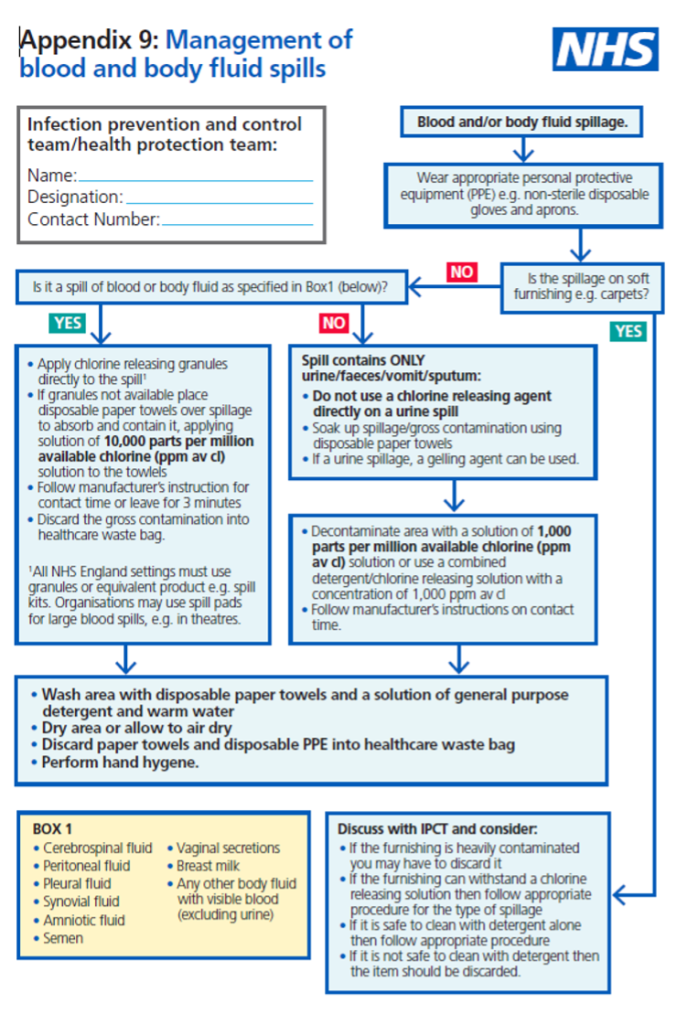Safe Management of the Care Environment
Safe management of the healthcare environment is essential to prevent cross-infections, as the contaminated environment has been associated with an increased risk of healthcare-associated infections (HAIs). Therefore, every healthcare facility should have written protocols for environmental cleaning to ensure that all areas of the environment are regularly cleaned to a satisfactory standard. Furthermore, they should be free of non-essential items and equipment to aid effective cleaning. In addition, to be visibly clean, the healthcare environment should be well maintained, in a good state of repair, and have adequate ventilation for the clinical speciality as per HTM 03-01.
Types of Environmental Surfaces
Environment surfaces are divided into two groups.
- Surfaces that come into frequent contact with hands are known as ‘high-frequency hand touch surfaces’, which include tabletops, work surfaces, door handles, etc. Cross-infection within healthcare facilities can occur by touching these surfaces by hand if hand hygiene is not performed between patients and after touching the contaminated environment.
To minimise cross-infection, these surfaces must be more frequently and thoroughly cleaned with warm water and detergent to prevent the build-up of biofilms and then disinfected. Thorough cleaning is essential as chemical disinfectants are inactivated by organic matter part. The frequency of cleaning must be increased in an outbreak situation. For high-frequency hand-touch surfaces after a thorough cleaning, disinfectants are also necessary to disinfect surfaces in a patient’s immediate surroundings to remove biofilm.
- Surfaces with minimal contact with hands are known as ‘low-frequency hand touch surfaces‘, including floors, window blinds, sills, walls, and ceilings. Since these surfaces have very low contact with hands, the risk of cross-infection is minimal. However, they should be regularly cleaned to ensure they are free from dust, dirt, or fungi. Therefore, cleaning these surfaces using warm water and detergent is sufficient, and disinfectants are not
General Principle
The following points should be taken into consideration when cleaning is undertaken:
- All personnel should be educated and given practical training to ensure that environmental cleaning is carried out effectively.
- Environmental cleaning staff should follow written protocols and have access to adequate resources, items and equipment to achieve the required standard.
- The use of detergents and chemical disinfectants for cleaning should follow COSHH regulations, and staff should use appropriate personal protective equipment (PPE) to protect themselves.
Method
- Wash hands, wear appropriate PPE (plastic apron and gloves), and follow local procedures and protocols.
- Display the warning signs for the slippery floor.
- The two or double-bucket method is recommended for cleaning the healthcare environment. One bucket is for clean water to which detergent (± disinfectant) solutions are added, and the other contains clean water for rinsing.
- Prepare the detergent and disinfectant solution per the manufacturer’s instructions.
- Do not mix/add chemicals, and don’t use an antiseptic solution.
- Use use warm water for cleaning as cold water affects the detergent’s effectiveness which helps in removing debris and organic matter. The water temperature should be between 27°C and 44°C because temperatures above 44°C can cause proteins to coagulate and prevent the removal of protein substances.
- Cleaning must always be carried out from the cleanest area first, finish in the dirtiest area last, and always clean from the top first and bottom last.
Types of Cleaning
For details, refer to the National Cleaning Standards for cleaning in different settings.
Routine Cleaning
- Routine cleaning of the environment should be undertaken at least
- Thorough cleaning with neutral detergent and warm water is commonly used. If soiled with blood and/or bodily fluids, general cleaning should be followed by disinfection (2.8.3).
Enhanced Cleaning
- During an outbreak of infection or an unusual increase in the incidence of particular microorganisms, enhanced routine cleaning (at least twice daily) is recommended.
- For cleaning low-frequency hand-touched surfaces, e.g. floor, window sills, and walls, cleaning with detergent is sufficient, and disinfectant is not necessary; always ensure
- However, frequently touched surfaces are thoroughly cleaned and then disinfected using compatible disinfectant products per the manufacturer’s recommendation.
- In addition to environmental cleaning, items and equipment should be cleaned and disinfected.
- In case of an outbreak of gastrointestinal infection, more frequent cleaning and disinfection are required in the sluice and sanitary areas.
For Terminal Cleaning, refer to the Transmission-based Precaution Section 3.
Safe Management of Blood and Body Fluid Spillages
Due to the risk of bloodborne viruses, spillages of blood and other body fluids should be contained and must be decontaminated immediately by staff trained to undertake this safely.
https://www.nipcm.hps.scot.nhs.uk/media/1701/2020-06-nipcm-appendix-9.pdf
If superabsorbent polymer gel granules for the containment of bodily waste are used, these should be used in line with national guidance.
https://www.england.nhs.uk/wp-content/uploads/2020/02/PS_Alert_Polymer_28_Nov_2019_FINAL.pdf
References
- National Standards of Healthcare Cleanliness 2021.London: NHS England and NHS Improvement, April 2021.
- National standards of healthcare cleanliness 2021: Appendices.London: NHS England and NHS Improvement, April 2021.
- CDC & ICAN. Best Practices for Environmental Cleaning in Healthcare Facilities in Resource-Limited Settings.CDC and Infection Control Africa Network, Version 2: 2022.
https://www.cdc.gov/hai/pdfs/resource-limited/environmental-cleaning-RLS-H.pdf
Ontario Agency for Health Protection and Promotion (Public Health Ontario), Provincial Infectious Diseases Advisory Committee. Best practices for environmental cleaning for prevention and control of infections in all health care settings. 3rd ed. Toronto, ON: Queen’s Printer for Ontario; 2018.
Literature Review
· Management of blood and body fluid spillages in health and care settings.July 2020.
https://www.nipcm.hps.scot.nhs.uk/media/1664/2020-07-sicp-lr-bloodspillages-v3.pdf
National Patient Safety Alert
- Risk of death and severe harm from ingesting superabsorbent polymer gel granules. 29 Nov 2019.
https://www.england.nhs.uk/wp-content/uploads/2020/02/PS_Alert_Polymer_28_Nov_2019_FINAL.pdf

